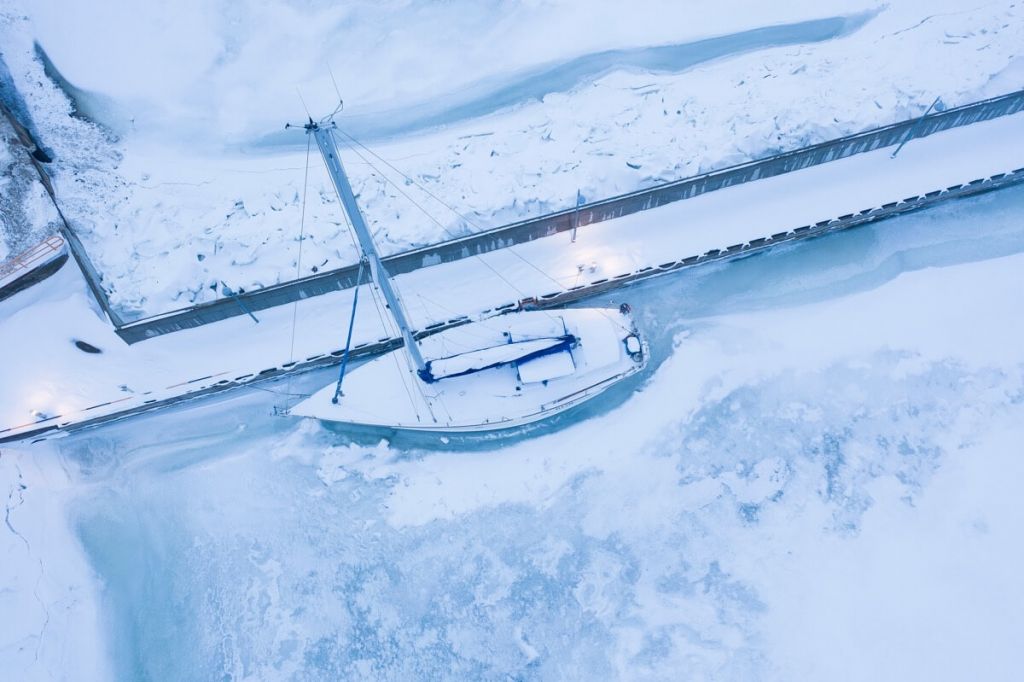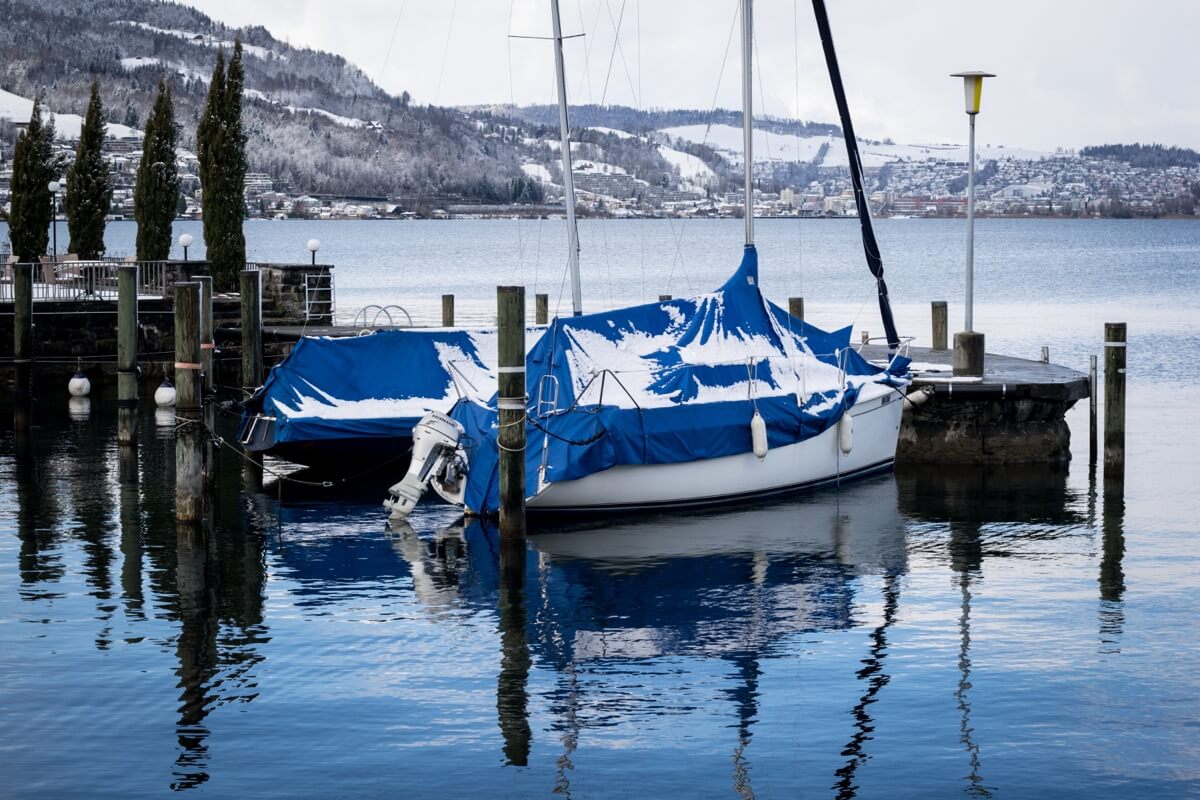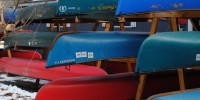The Complete Checklist for Winterizing Your Boat (Free PDF)
More than twenty years ago, when I bought my first boat, I didn't have a clue about a lot of things. As the first sailing season was winding down, a friend asked me about my plans for "winterizing" the boat.
Huh?
I'm sure my dumb look was priceless. As a new boat owner, I'd been more concerned with figuring out which lines went where and how to get in and out of a slip with all my gel coat intact than any thoughts for the winter.
Winterizing a boat means securing every system on the boat against freezing, corrosion, and damage from cold while preparing the boat for layup and disuse.
Systems get drained, flushed, and filled with antifreeze; the boat gets covered and protected from snow and ice; and engines and mechanical systems are cleaned, lubricated, and stored so they start up again easily in the spring.
Sounds like a lot of work, right? It can be, but it depends on the size of your boat. A large boat with multiple complex systems will take some time, but a simple day sailor with an outboard can be done in an afternoon.

Interactive Checklist of Winterizing Steps and Supplies
It's not complex, you just need to know what to do for the specific systems on your boat. This is more of a checklist than a detailed step-by-step guide, so you understand what you're getting into and what needs to be done.
Summary
- Winterizing your boat includes draining all water from the boat, adding antifreeze to the engine and plumbing systems, and removing all electronics and batteries.
- Fill up your fuel tanks and add a fuel stabilizer to prevent the fuel from degrading over the winter. Run the engine for a few minutes to circulate the stabilized fuel throughout the system.
- Clean and dry your sails thoroughly before storing them. Remove any stains or mildew with a sail cleaner. Fold the sails carefully and store them in a dry, cool place.
- Clean the hull and remove any marine growth, such as barnacles or algae. Apply a coat of wax or polish to protect the hull from the elements. Cover the boat with a breathable cover to prevent moisture buildup.

On this page:
Boat Winterization Checklist
It's important for boat owners like you to carefully follow a comprehensive winterization checklist and ensure that all necessary steps are taken to properly protect the boat from winter weather damage.
-
Drain all water from the boat, including the fresh water and holding tanks, as well as the bilge. Be sure to open all faucets and valves to allow all water to drain out.
-
Add non-toxic Propylene Glycol antifreeze to the engine and plumbing systems to prevent freezing and corrosion. Be sure to follow the manufacturer's instructions for the correct amount to use.
-
Remove all electronics and batteries from the boat and store them in a dry, cool place. This can help prevent damage from moisture and extreme temperatures.
-
Clean the hull and remove any marine growth, such as barnacles or algae. Apply a coat of wax or polish to protect the hull from the elements.
-
Fill up your fuel tanks and add a fuel stabilizer to prevent the fuel from degrading over the winter. Run the engine for a few minutes to circulate the stabilized fuel throughout the system.
-
Cover the boat with a breathable cover to prevent moisture buildup. Be sure to secure the cover in place to prevent it from coming loose during high winds.
-
If you plan to leave the boat in the water, install a de-icer to prevent ice from forming around the boat and damaging the hull.
-
Consider using a dehumidifier or moisture absorber in the cabin to prevent mold and mildew from forming over the winter.
-
Inspect all safety equipment, such as life jackets, flares, fire extinguishers, and first aid kits. Replace any expired or damaged items.
-
Check all ropes, lines, and rigging for wear and tear. Replace any damaged or worn out components.
-
Remove any valuables or items that may be damaged by moisture or extreme temperatures.
-
Secure the boat to its mooring or trailer and ensure that it is properly supported.
-
Consider having a professional mechanic or boatyard perform a full winterization service to ensure that your boat is properly prepared for the winter season.
-
Make sure that you have adequate insurance coverage for your boat over the winter months.
Sailboat winterization checklist
Here's are the specific checks for sailboats:
-
Clean and dry the sails thoroughly before storing them. Remove any stains or mildew with a sail cleaner. Fold the sails carefully and store them in a dry, cool place.
-
Remove the mast and store it separately in a dry, cool place. Inspect the mast for any damage or wear and replace any worn or damaged components.
Supplies you may need
Your specific needs for winterizing will vary with the systems on your boat and the type of engine and fuel you have and the type of storage you choose. Quantities will vary with the size and complexity of your systems.
- Non-toxic Propylene Glycol antifreeze - the "Pink Stuff" (water systems, engine, bilge) for -50F protection, or -100F for colder climes (usually green or blue). Do not use Ethylene Glycol or auto-anti-freeze for winterizing. It is highly toxic to you and to marine life.
- Engine oil and filter (engine)
- Fogging oil (engine)
- Fuel stabilizer/biocide (engine)
- Antifreeze Hydrometer or "antifreeze tester" (engine)
- A cover - shrink wrap, tarps, a canvas cover, or indoor storage
- Dehumidifying agent or dehumidifier/heater (cabin)

Do You Have to Use Antifreeze to Winterize a Boat?
Winterizing Specific Parts of Your Boat
The engine and generator
The task for all engines is similar, though the specific steps vary.
- Rinse and flush the engine with freshwater to remove salt.
- "Fog" the engine with a spray oil.
- Flush antifreeze through the engine.
- Change the oil and oil filter.
- Change fuel filters.
- Close through hulls on intakes and fill strainers with antifreeze.
Inboard engines
Freshwater cooled inboard engines have a few more steps for safety.
- Check antifreeze level in the engine block with a tester and add anti-freeze as needed to maximize cold protection. Make sure you circulate the new mix before re-testing.
- Flush and fill the engine and lines with antifreeze.
Outboards
You also have to winterize the outboard motor. Here's how:
- With the engine running, disconnect the fuel line and run the engine until it stops. This empties all the fuel from the carburetor.
- Change lower unit oil.
Learn more about what happens to your engine if you don't winterize your boat here.
Marine diesel winterization checklist
If you have a marine diesel engine, it's important to follow this checklist that includes changing the oil and oil filter, adding a fuel stabilizer, and draining all water from the engine.
-
Check the manufacturer's recommendations for the proper temperature range for your diesel engine. Diesel fuel can begin to gel or solidify at temperatures below 32°F (0°C), which can cause damage to the engine.
-
Drain the antifreeze and coolant from the engine and replace it with a non-toxic Propylene Glycol antifreeze to prevent freezing and corrosion. Be sure to follow the manufacturer's instructions for the correct amount to use.
-
Change the oil and oil filter before storing the boat for the winter. This can help prevent moisture buildup and corrosion in the engine.
-
Add a fuel stabilizer to the fuel tank to prevent the fuel from degrading over the winter. Be sure to follow the manufacturer's instructions for the correct amount to use.
-
Run the engine for 10-15 minutes to circulate the stabilized fuel throughout the system.
-
Drain all water from the engine, including the fresh water and raw water cooling systems, as well as the heat exchanger. Be sure to follow the manufacturer's instructions for the proper method of draining the water.
-
Replace the raw water impeller to prevent it from becoming brittle over the winter. This can help ensure that the engine is ready to go when boating season starts up again in the spring.
-
Replace the fuel filter to prevent any contaminants from building up in the fuel system over the winter.
-
Add a biocide to the fuel tank to prevent algae growth. Be sure to follow the manufacturer's instructions for the correct amount to use.
-
Fill up the fuel tank to prevent condensation buildup. This can help prevent moisture from building up in the fuel tank over the winter.
-
Remove the engine's zinc anodes and replace them with new ones before storing the boat for the winter. This can help protect the engine from corrosion.
-
Cover the engine with a breathable cover to prevent moisture buildup. Be sure to secure the cover in place to prevent it from coming loose during high winds.
Fuel systems
Diesel fuel
- Add a biocide/stabilizer to the fuel tank.
- Fill the tank after you add the stabilizer.
Gasoline
-
Most gasoline outboards use a removable tank. This fuel should be disposed of properly or used for some other purpose, so you start with a fresh tank in the spring. (I used to put my leftover dinghy fuel into my car.)
-
If you have an older boat with a gasoline inboard and a permanent tank installed, you can drain it, or add a stabilizer and fill it.
Plumbing systems
Pressure (fresh) water
- Flush all tanks and lines.
- Add antifreeze to the water tank.
- Run all fixtures until antifreeze runs out, starting with the fixtures farthest from the pump.
Water heaters
- Drain all water.
- If there is a winterizing bypass, shut it off before winterizing the pressure water system so you don't have to fill the tank with expensive antifreeze.
- Disconnect the electricity or turn off the breaker to prevent accidental startup in the spring while it's empty.
Heads and toilets
- Flush all toilets with fresh water
- Pump out and rinse all holding tanks.
- Using the water intake hose, flush the system through with antifreeze

Refrigeration
- Flush all raw water lines with antifreeze
The bilge
- Pump or drain the bilge into a proper receptacle.
- Add antifreeze to cover exposed pumps or through hulls
- Run the pump briefly and fill it with antifreeze.
Batteries
Most boats in seasonal cruising regions are still using Lead-Acid batteries - either flooded (wet) cells, AGM, or Gel. There are minimal differences between lead-acid types when winterizing, but LiFePO~4~ banks require different long term layup care.
Lead-acid
- For wet cells, top up all cells as per manufacturer's instructions (usually with distilled water).
- Fully charge all batteries.
- Disconnect electrical connections from the boat.
- If practical for smaller batteries, remove them and store them indoors with a trickle charger.
Lithium (LiFePO~4~)
Consult your manuals for details on longer term layup instructions and periods of disuse. LiFePO~4~ technology is fairly new, and manufacturer recommendations should be followed when available.
- Charge/Discharge to 50% state of charge or the manufacturer's recommended storage voltage.
- Disconnect all connections from the boat.
Air conditioning
- Flush and fill raw water lines with antifreeze.
Water maker
Be sure to read the manual and follow all the steps in order. Sending pressurized antifreeze through your membrane can damage it.
- Pickle membrane with preservative as per manufacturer's instructions.
- Flush raw water intake systems with antifreeze.
- Replace or remove all filters.
Covering, ventilation and moisture
Boat covers
Boats stored outdoors in places with freezing temperatures should be covered. While a detailed discussion about boat coverings and types of covers is beyond the scope of this article, you should be aware that there are multiple options.
- Canvas covers: Expensive up front, but reusable from season to season and the best environmentally and for the boat.
- Shrink wrapping: An annual expense that you may want to leave to the pros to do. Should be recycled in the spring.
- Tarps and improvised materials: Smaller boats can be covered with tarps and other inexpensive materials, but they are prone to blowing off and coming loose. Tarps are difficult to secure on wet-stored boats since you can’t get lines under the hull easily.
Ventilation and moisture
Stagnant air and trapped moisture are the leading causes of mold and mildew growth on boats in the winter.
- Make sure any boat covers have leak-proof ventilation and allow airflow.
- Open all cabinets and storage areas, empty lockers where airflow is restricted.
- Remove mildew prone items such as towels and clothing for the season and store them off the boat.
- Consider chemical desiccants, a fan, a winter cabin heater, and/or a dehumidifier.
- If security permits, leave some windows or a hatch open under the cover.
Sails
- Rinse and sails with fresh water and allow to dry prior to flaking.
- Take any sails in need of repairs to a sail loft.
- Consider annual inspection, cleaning, and winter storage with a sailmaker to extend sail life.
Store the Boat
You must make arrangements well in advance for a place to store the boat for the winter. Considerations of budget, local climate, and geography will drive this, and each storage method has advantages and disadvantages.
Boat winter storage checklist
-
Choose a storage location that is dry, cool, and secure. This could be a garage, storage facility, or marina.
-
Clean and dry the boat thoroughly before storing it. This includes the hull, deck, and all interior spaces.
-
Remove all electronics and batteries from the boat and store them in a dry, cool place. This can help prevent damage from moisture and extreme temperatures.
-
Choose a boat cover or shrink wrap to protect the boat from the elements. A boat cover can be made from a variety of materials, such as canvas, polyester, or vinyl. Choose a cover that is breathable to prevent moisture buildup.
-
If you're on a budget, consider using a tarp to cover the boat instead of a custom-made cover. However, be sure to secure the tarp in place to prevent it from coming loose during high winds.
-
If you have a sailboat, consider using a cheaper and quicker method for winterizing your boat, such as removing the mast and storing it separately.
-
Install a dehumidifier or moisture absorber in the storage space to prevent mold and mildew from forming over the winter.
-
Check on the boat periodically throughout the winter to ensure that the cover or shrink wrap is secure and that there are no signs of damage or moisture buildup.
Hard stands/dry storage
Dry storage is most common in colder areas where salt water may freeze. Your boat can't sink on the hard, and it will be available to work on, though you'll need a ladder.
Taking the rig down for the winter is usually not required, but it will afford the opportunity to inspect and service the rig in the off season and reduces windage if you store in a storm prone area.
In-water storage
In-water storage is a good budget alternative, but it needs different steps.
- Keep bilge connected to a battery.
- Keep batteries charged for bilge pumps.
- You may want "Ice Eaters" in the slipe for areas prone to freezing.
Trailer
Trailered boats are easy and cheap to store if you've got space. Be sure to still cover the boat and winterize systems unless you're storing it indoors.
Indoor storage
Indoor storage removes the need for a cover, but will usually require mast removal. Take care to still winterize systems if your storage building is not heated.

Do I Need to Winterize an Indoor Stored Boat?
Visit your boat
"Out of sight, out of mind" is a common problem with winter storage. Except for violent storms, most winter storage damage doesn't happen quickly. It's the result of creeping effects, like water seeping in and freezing, mold growing in damp, stagnant spaces, or heavy weights of snow and ice pressing on covers and breaking them.
So make the time in the winter to check your boat now and then. After a snow or big freezing rain storm, check for accumulation on the cover and leaks and incursions. Nip problems in the bud. When you open up a clean boat that smells nice in the spring, you'll forget that cold day in February when you swept the snow off the shrink wrap.
The best prevention in the fall won't help you if something goes wrong and unchecked for the rest of the winter.
Did you find the answer to your specific question?
👍 0 👎 1


Leave a comment